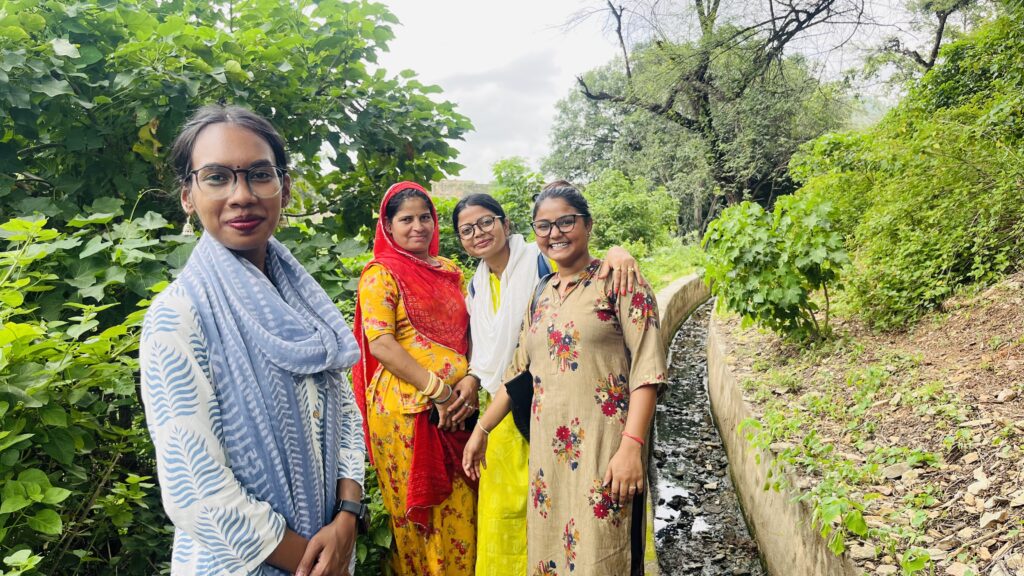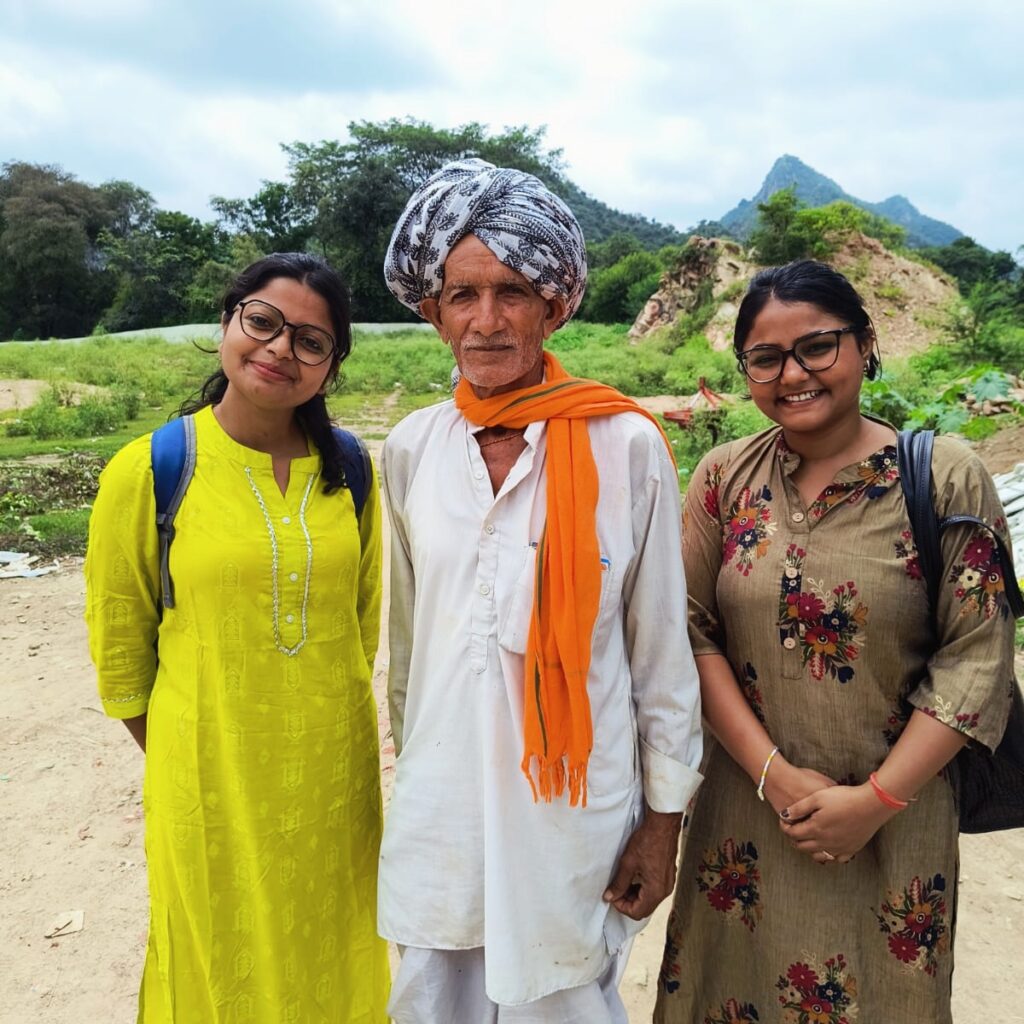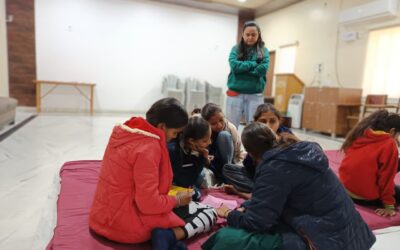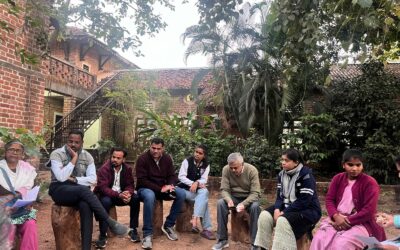On 16th August, during our induction training with India Fellow in Udaipur, we visited Madar village, an experience that would challenge our preconceptions of rural life.
Coming from a city, I approached the day with a blend of curiosity and uncertainty. Though I had visited villages before, this time felt different—I was now equipped with a new lens, observing not just with the eyes of an outsider, but with an intention to understand the realities beneath the surface. Along with four colleagues, we embarked on this journey, ready to immerse ourselves in the life of the village.
The Journey To Madar Village
Leaving our campus, we boarded a bus for the 11km trip to the village. Sitting on top of the bus became one of the day’s highlights, filling us with excitement and anticipation. There was a collective sense of curiosity and nervousness about what we might discover, but a quiet confidence carried us forward.
Upon arrival, our expectations were immediately challenged. The bus stop resembled a semi-urban setting more than the typical rural village I had imagined. Gone were the images of kutcha roads and mud houses; instead, we were greeted by pucca roads, well-maintained schools, and health centers. Students in crisp uniforms passed by, further surprising us with how different this village was from the stereotypical portrayal.
The stereotypes we held came from a lifetime of media, literature, and second-hand stories that shaped our view of rural India. Often, villages are depicted as underdeveloped, disconnected, and lacking basic infrastructure. Growing up, our parents would often describe villages as places that lacked even the basic amenities a city child would need—no electricity, limited access to education, and scarce healthcare facilities. They would speak of how difficult it would be for us to adjust in such a setting, warning us that we wouldn’t last long without the comforts we were used to.
A Semi-Urban Reality
Our first interaction was with a physical training instructor from Maharashtra, who had an intriguing story to share. Standing in the heart of the village’s central chowk, he told us about his journey. Originally from Maharashtra, he had lived in Gujarat for several years and picked up fluent Gujarati. His life had taken him to various big cities for education and work, giving him a unique perspective on both urban and rural life. Despite these travels, he had chosen to settle in Madar, where he saw immense potential in nurturing the local community, especially the youth.
As we chatted, a small girl, no older than 12, approached us. She was a class 6 student preparing for a wrestling contest in the coming week. The instructor proudly told us that he had been training her for the event. What struck us most was the level of support she received—not just from her family, but also from her school and the broader village community. Here was a young girl, empowered and encouraged to pursue a traditionally male-dominated sport, and her ambitions were met with enthusiasm. This interaction revealed a side of rural life that we hadn’t expected: one where gender roles were being redefined, and where progressiveness was embraced at every level.
As we walked deeper into Madar, we found more surprises. Two-storey pucca houses lined the streets, their brightly colored walls a testament to the village’s vibrancy. Small tea stalls were buzzing with locals, engaged in animated conversations, and grocery shops were well-stocked with everything from fresh vegetables to modern packaged goods. The streets were not only well-paved but also clean and orderly. We passed well-maintained schools, health centers, and regular temples dedicated to Shiva and Parvati, which blended tradition with the community’s evolving modernity.
Bonding By The Lake
One of the day’s highlights was reaching the Madar Bada Talab, a serene lake surrounded by small hills and agricultural fields. This tranquil setting offered a stark contrast to the hustle of city life and fostered a deeper bond among my colleagues. As we sat by the water’s edge, conversations naturally flowed about our lives, struggles, and uncertainties.
We found solace in each other’s experiences, which strengthened our connection. Feeling inspired, we decided to trek up a small hill toward a tiny island in the middle of the lake. The journey wasn’t easy, but reaching the island filled us with joy, momentarily pushing our worries aside and replacing them with a sense of adventure. The lake, the hills, and our shared trek symbolized the peacefulness we found in Madar and the growing bond that would carry us through the challenges ahead.
A Conversation With Manju
Our journey took another turn when we met Manju, a farmer and a woman of remarkable resilience, on our way back to the village from the dam. She was on her way to her field, dressed in a stunning traditional Rajasthani skirt and a fitted top, elegantly complemented by a beautiful dupatta that draped gracefully over her. Her attire was a vivid representation of her culture, and as she approached us, her demeanor was warm and inviting.
Contrary to our assumptions, she spoke of family trips, staying in hotels, and leading a lifestyle not so different from urban dwellers. Her candid conversation revealed that they are not out of touch but rather live rich, fulfilling lives that blend tradition and modernity.
What struck us most was her openness; she engaged with us like a young girl eager to share her experiences. In fact, she invited us to lunch the next time we visited, which felt like a genuine gesture of hospitality. However, amidst her stories of joy, she also shared her concerns about the changes in the village. She discussed how the influx of hotel owners was encroaching on the hilly areas, destroying the local culture and diminishing the space available for grazing their cattle.
Moreover, she expressed worries about the increasing safety threats for women due to the rise in tourism linked to the hotels and the dam. Her awareness of these pressing issues highlighted her deep connection to her community and its evolving challenges. Meeting Manju was a reminder that village life is multifaceted, filled with both vibrant experiences and complex realities.

The Surprise Encounter With A Farmer
This encounter was a significant revelation for us, as it shattered our preconceived notions about rural life being disconnected from the outside world. In my entire life, I had often encountered farmers in my village and surrounding areas, and they rarely spoke English or engaged in conversations beyond basic exchanges. I vividly recalled instances where, in my attempts to communicate, I had mistakenly used English words, only to be met with blank stares or requests to speak in Hindi.
Those experiences led me to develop a single story about farmers, framing them as limited in their exposure to different languages and cultures.
But meeting this farmer reminded me that my past encounters were not representative of all rural communities. His ability to converse in English highlighted the diverse experiences within farming communities that I had previously overlooked. It made me reflect on how easy it is to generalize based on a few interactions, ultimately limiting my understanding of a larger group.

The village showcased a strong sense of community, with locals actively supporting events and initiatives. Small businesses flourished side by side, from tea stalls to jewellery shops, resembling the vibrant markets of the city. Madar celebrated its rich traditions, reflecting the cultural vibrancy often found in urban settings. The villagers expressed aspirations for education and personal growth, showcasing a universal desire for progress. Like cities, Madar was adapting to modern influences while preserving its unique heritage.
After this encounter, I felt a mix of humility and excitement. It was a reminder that there is so much more to learn about the lives of people in rural areas, and that the narratives we often hear are just fragments of a much larger story.I realized that moving forward, I needed to approach every new interaction with an open mind, ready to discover the unexpected layers of people’s lives.




0 Comments